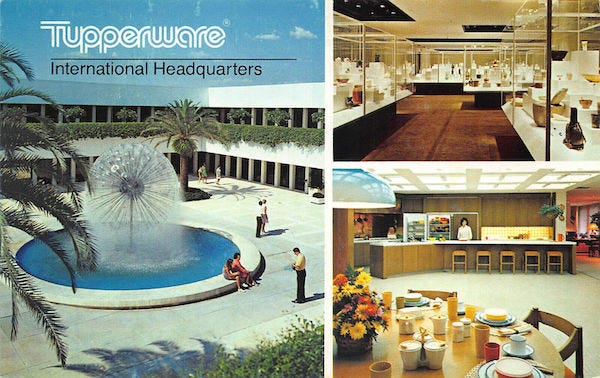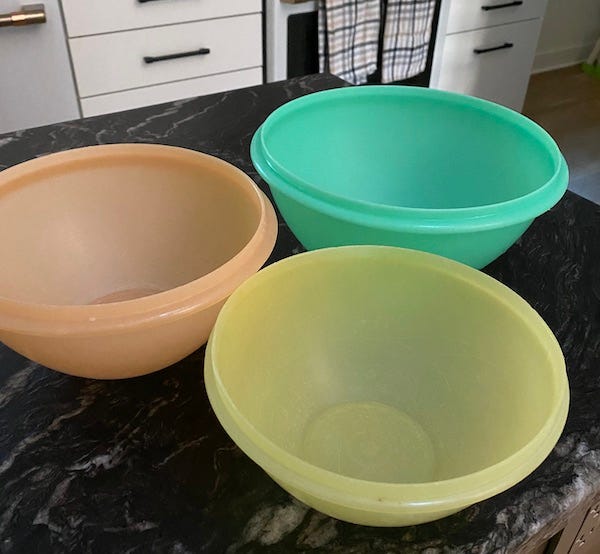Wednesday Walk: I'm Going to Tupperware!
How plastic containers reshaped Orlando before Disney and more Radio Shack oddities
Welcome to Willoughby Hills!
If you enjoy what you’re reading, please consider a free subscribtion to receive emails every Wednesday and Sunday plus podcast episodes every two weeks. There are also paid options, which unlock even more features.
As is typical every Wednesday, I’m bring you a smattering of topics that I hope will make you a bit more curious about the world around you and give you something to think about later. I call these Wednesday Walks, as it’s the type of conversation we might have walking down a path in the woods. Shall we take a stroll?
One Free Battery

Before diving into this week’s issue, I wanted to share interesting feedback from a reader to last week’s Wednesday Walk about missing Radio Shack but discovering a really cool local electronics shop instead.
In the comments on that post, Harry mentioned that one of the things he liked about shopping at Radio Shack was belonging to the Battery of the Month club. Harry linked to a blog post which describes how Radio Shack used to hand out one single battery every month. Like as in one AA battery, one 9 volt, etc. I had no memory of this program so I was very interested to read it.
Calling the program a “club” is a little odd, as it didn’t involve any membership dues or payment. You simply gave Radio Shack your information and were issued a card that was redeemable for one free battery each month. According to the blog post by Drew Durgian:
“Here’s how it worked: You would go into your local Radio Shack, sign up and be issued a card. Bring the card back each month and redeem for one free standard Radio Shack ‘AA’, ‘C’, ‘D’, or 9-volt transistor battery. The salesperson would mark off that month on the back of the card. Return next month and repeat the process.”
It was a logical way to bring customers in the store, hopefully to browse for other items or perhaps to purchase additional batteries as well (who only needs one battery?!).
For Radio Shack, I suppose they were getting some data through this program too, although they didn’t necessarily need that information. Readers of a certain age may remember that the store would routinely ask for a phone number when making a purchase, so they already knew who you were and what your spending habits were like. (If you don’t remember shopping in the store, you likely are too young for Seinfeld, but Kramer once made a quip about the practice on the show).
If you had saved your one free battery from this promotion from 30 or 40 years ago, you would be making quite the return on that “investment.” The vintage battery image at the top of this section came from an eBay auction where a single 9 volt battery is currently listed at $7.95 plus shipping.
One last curiosity: while Radio Shack’s stores may be long gone, the brand is still alive. If you visit Radioshack.com, you’ll be greeted with the tag line “Shack is Back” along with a selection of electronics and apparel with the famous logo on them.
The strange thing is that the top banner on the site seems to be a graveyard of forgotten brands: Linens n Things, Pier 1, Dress Barn, Steinmart, and Modell’s, among others.
It turns out that Radio Shack and all of these other brands were acquired by Retail Ecommerce Ventures (REV) after liquidating their physical locations. REV’s business model is to buy the intellectual property associated with dead brands (brand name, logo, URL, private label brands, etc) and revive them through e-commerce. There’s an interesting write up on CNN.com about the practice, plus some controversy that Radio Shack generated on its Twitter account under REV’s management.
I suppose it shows that nostalgia is a powerful business and names still have power, even if the stores that once had those names are now vacant or occupied by other retailers.
Tupperwareland

Speaking of impending bankruptcies, it seems that the days may be numbered for home storage company Tupperware.
I recently came across an interesting article by Austin Fuller in the Orlando Sentinel titled “Once the ‘Magic Kingdom before Disney,’ Tupperware faces dire future.” The article appears to be behind a paywall now, but it tells the story of Tupperware’s relationship to the city of Orlando. As I’ve learned, there is always a local angle to any story!
Unbeknownst to me, Tupperware helped build a tourism market in central Florida nearly two decades before Disney or other theme park operators had a presence there.
The local impact started in 1954, when Tupperware relocated to Orlando, according to Fuller’s piece:
“Tupperware would become a draw for visitors to Central Florida and a vital part of the Orlando community, said Bob Kealing, author of Life of the Party, a book about Wise and Tupperware…
‘The whole area was largely agrarian and Tupperware … it’s fair to say really started to spark that evolution from agrarian to not only business, but tourism-focused,’ Kealing said.”
According to Tupperware’s website, the company was founded in 1946 when chemist Earl Tupper invented a plastic container with an airtight seal. The company began in New England and Tupper tried to sell his new product to hardware stores and department stores. The containers were so innovative that consumers didn’t quite understand them, leading to lackluster initial sales.
According to American Experience, Brownie Wise, a saleswoman with experience selling directly to consumers through a home party model, was the visionary who helped turn these containers into become household staples.
Wise eventually joined the company as a Vice President and recruited housewives across the country to sell Tupperware to their friends at small gatherings. These “Tupperware parties” allowed for social interactions in the otherwise isolating new suburbs, were a chance for women to have meaningful employment at a time when many were expected to stay home and raise children, and were a way to showcase the proper “burping” of a Tupperware container. Once women (and the early customers were predominantly women) understood how the containers worked, they saw the value in them and eagerly bought them.
Brownie Wise as a female executive became a model for her sales force. Quoting again from the Orlando Sentinel:
“‘She was like Cher or Madonna. She was Brownie,’ [author Bob Kealing] said. ‘Scores of families across America prospered because of selling this product. It worked. People needed it. They needed to stretch home budgets in the days after World War II.’”
A trip to Tupperware headquarters in Orlando was a motivation for many saleswomen, and from the sounds of it, they were greeted with opulence upon arrival:
“Tupperware dealers would travel to Orlando for recognition, and for celebrations at the headquarters near the Orange County line on Orange Blossom Trail, Kealing said. He added the company established a public art collection, and school graduations have been held in Tupperware Auditorium.
‘They were an intrinsic part of the community far beyond the plastic storage products,’ Kealing said.”
As is often the case with a failing business, it seems that Tupperware didn’t adapt fast enough to changes in their business and the culture at large. While they have experimented with online sales and placing their products in retail outlets, the primary sales avenue is still direct sales through independent sales representatives.
Speaking personally, we try to avoid storing food in plastic containers and certainly avoid reheating food in plastic. I’m much more likely to opt for a glass or stainless steel container for my leftovers.
While I would happily purchase something online, I really have no interest in purchasing anything directly from an independent representative. Even if it’s fully legitimate (and in this case, there’s a 70 year history to back it up), it still feels like a scam or a pyramid scheme to me. Maybe that’s just because I don’t have a friend or neighbor that I trust who is selling me the items and I would have to shop through a stranger. This may say more about how little I know my neighbors, an interesting sociological study in itself.
I will say though that Tupperware is incredibly durable. My mom has had a set of mixing bowls with lids for my entire lifetime and they still are a fixture in her kitchen.
I never gave those bowls much thought when I would see them pulled out for birthday parties or Thanksgiving dinners in my youth, but now I see them as an interesting historic relic. There’s a whole story in those bowls about our relationship to plastic, gender roles in the workforce, and even how the perception of community has evolved. Tupperware is seeking a buyer to keep the brand alive, but whether or not that happens remains to be seen.
That little article in the Orlando Sentinel makes me want to read Life of the Party and learn more about this time that was not so long ago but feels completely foreign to me too.
Shoutouts
I’ve been meaning to do more of these shoutouts, but I haven’t been as good about it. Luckily, this week I had something I wanted to put on your radar!
Scott Foley, who was the first guest ever on the podcast and one of the few guests to be on twice, is currently starring in the Broadway version of The Thanksgiving Play at the Helen Hays Theatre in New York. The show’s run was recently extended through June 11. Seema and I are planning to head to NYC in a few weeks to see it and I encourage you to go too! Also starring with Scott: D’Arcy Carden, Kate Finneran, and Chris Sullivan. You can learn more and buy tickets here.
If you have an item that you’d like me to include in a future Shoutout, please send it my way! I love hearing what you’re all up to and it’s sometimes hard for me to keep track on my own.
Thank you for reading! Did you get something out of today’s issue? I always love hearing your thoughts, so please drop a line in the comments.
I publish new issues every Wednesday and Sunday. Sign up to always receive the latest issue and support my work:
Other Wednesday Walks
If you’ve missed past issues of this newsletter, they are available to read here.








Wow, great picture of the battery! You're right, wish I still had one. Wouldn't sell it.